Technical Briefing Paper: Urban Stormwater Management (ENN544)
VerifiedAdded on 2022/10/01
|12
|6148
|18
Report
AI Summary
This technical briefing paper, prepared for the ENN544 Sustainable Practice in Engineering course at QUT, delves into the critical issue of urban stormwater management. It explores the concept and importance of stormwater management, emphasizing its role in mitigating flood risks and environmental pollution. The report examines various factors influencing stormwater management, including social, regulatory, geological, economic, and technical aspects. It further details key strategies for managing stormwater runoff, categorizing techniques into conveyance-oriented and storage-oriented methods. Conveyance techniques are assessed for their role in quick drainage, while storage methods, including onsite, regional, and community storage, are evaluated for their effectiveness in reducing runoff and promoting infiltration. The paper concludes by highlighting the importance of education, innovation, and strategic planning for developing effective stormwater management practices. The report uses QUT APA referencing style and follows the guidelines for a technical briefing paper, including an abstract, introduction, body sections, conclusion, and references.
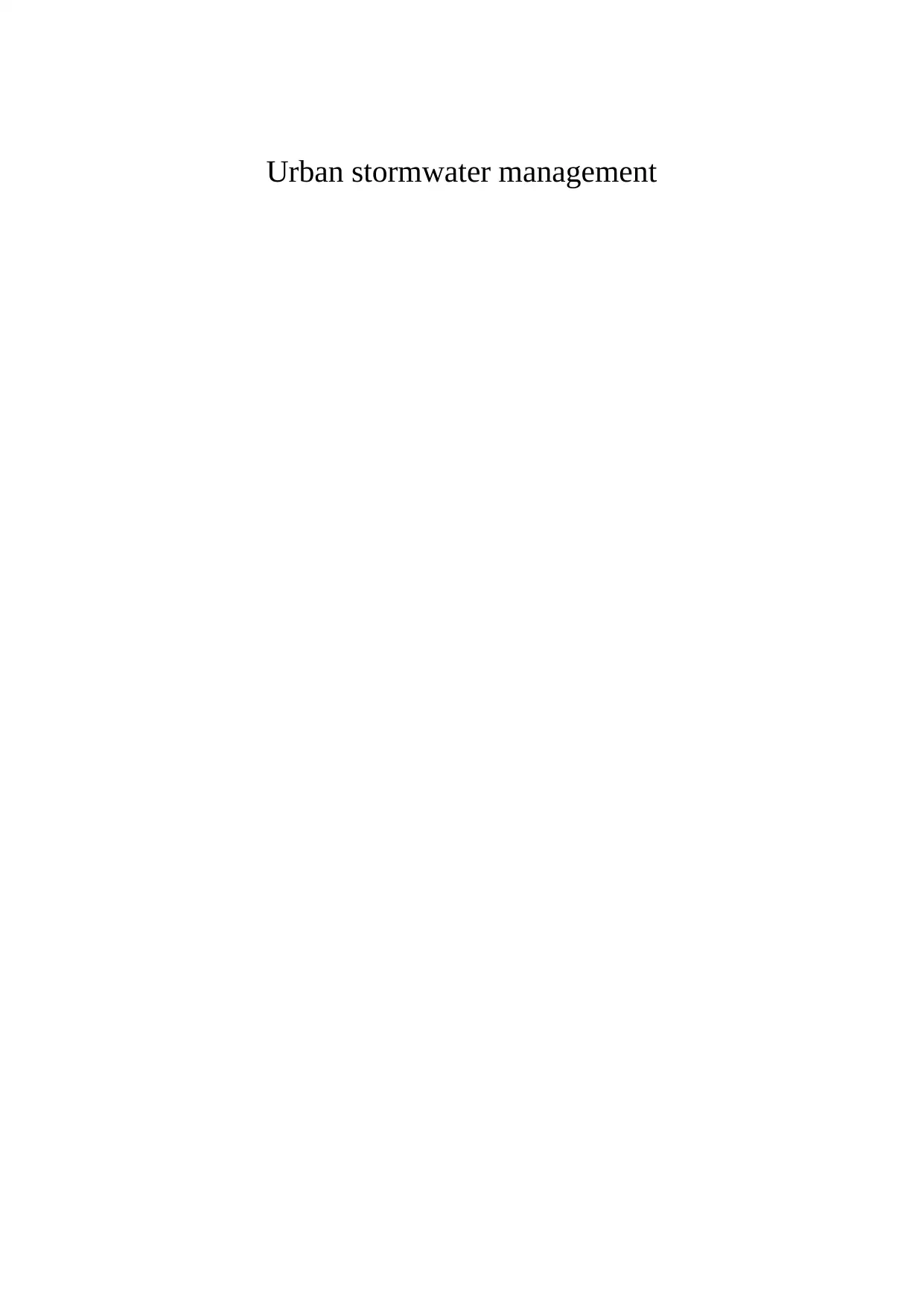
Urban stormwater management
Paraphrase This Document
Need a fresh take? Get an instant paraphrase of this document with our AI Paraphraser
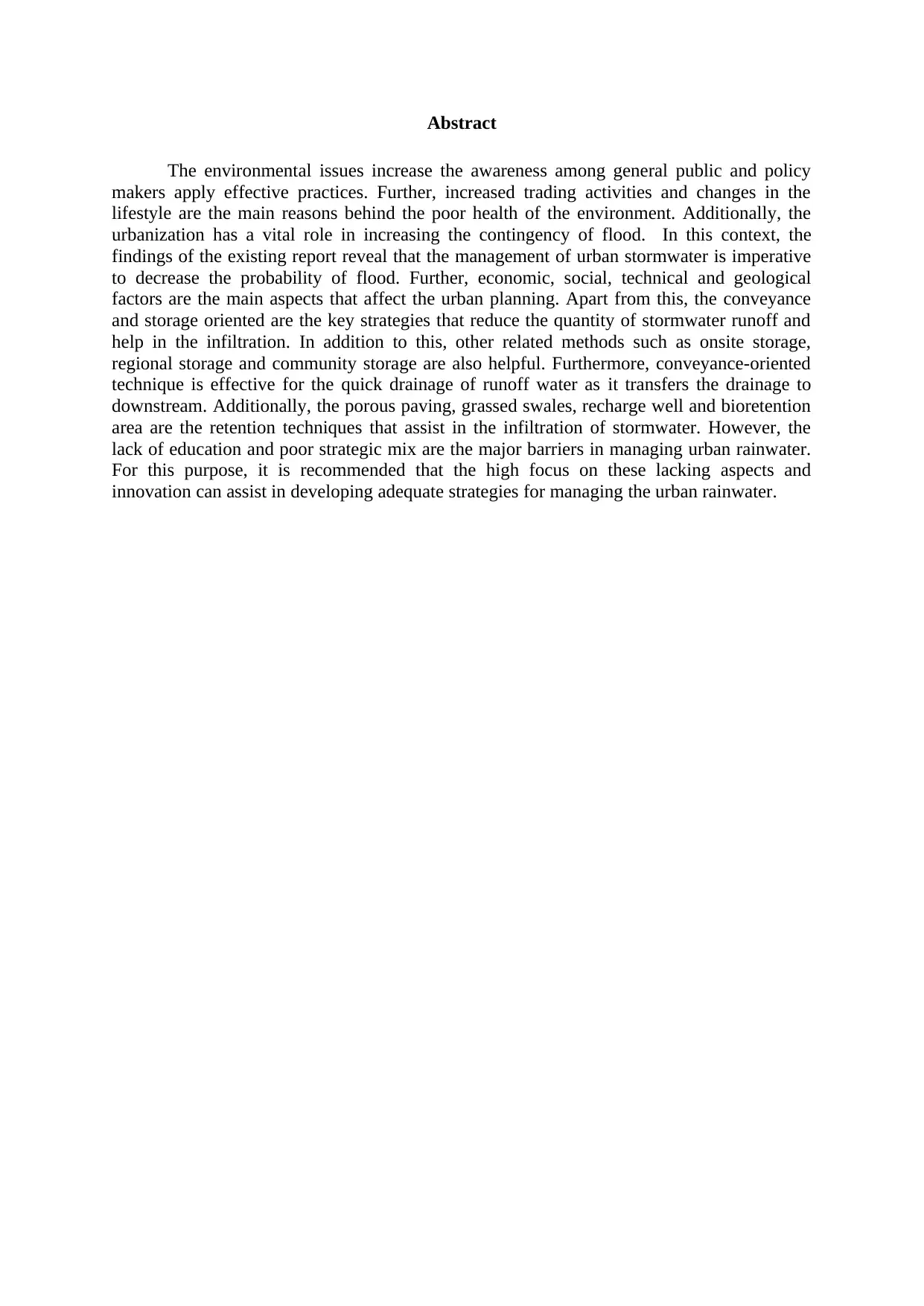
Abstract
The environmental issues increase the awareness among general public and policy
makers apply effective practices. Further, increased trading activities and changes in the
lifestyle are the main reasons behind the poor health of the environment. Additionally, the
urbanization has a vital role in increasing the contingency of flood. In this context, the
findings of the existing report reveal that the management of urban stormwater is imperative
to decrease the probability of flood. Further, economic, social, technical and geological
factors are the main aspects that affect the urban planning. Apart from this, the conveyance
and storage oriented are the key strategies that reduce the quantity of stormwater runoff and
help in the infiltration. In addition to this, other related methods such as onsite storage,
regional storage and community storage are also helpful. Furthermore, conveyance-oriented
technique is effective for the quick drainage of runoff water as it transfers the drainage to
downstream. Additionally, the porous paving, grassed swales, recharge well and bioretention
area are the retention techniques that assist in the infiltration of stormwater. However, the
lack of education and poor strategic mix are the major barriers in managing urban rainwater.
For this purpose, it is recommended that the high focus on these lacking aspects and
innovation can assist in developing adequate strategies for managing the urban rainwater.
The environmental issues increase the awareness among general public and policy
makers apply effective practices. Further, increased trading activities and changes in the
lifestyle are the main reasons behind the poor health of the environment. Additionally, the
urbanization has a vital role in increasing the contingency of flood. In this context, the
findings of the existing report reveal that the management of urban stormwater is imperative
to decrease the probability of flood. Further, economic, social, technical and geological
factors are the main aspects that affect the urban planning. Apart from this, the conveyance
and storage oriented are the key strategies that reduce the quantity of stormwater runoff and
help in the infiltration. In addition to this, other related methods such as onsite storage,
regional storage and community storage are also helpful. Furthermore, conveyance-oriented
technique is effective for the quick drainage of runoff water as it transfers the drainage to
downstream. Additionally, the porous paving, grassed swales, recharge well and bioretention
area are the retention techniques that assist in the infiltration of stormwater. However, the
lack of education and poor strategic mix are the major barriers in managing urban rainwater.
For this purpose, it is recommended that the high focus on these lacking aspects and
innovation can assist in developing adequate strategies for managing the urban rainwater.
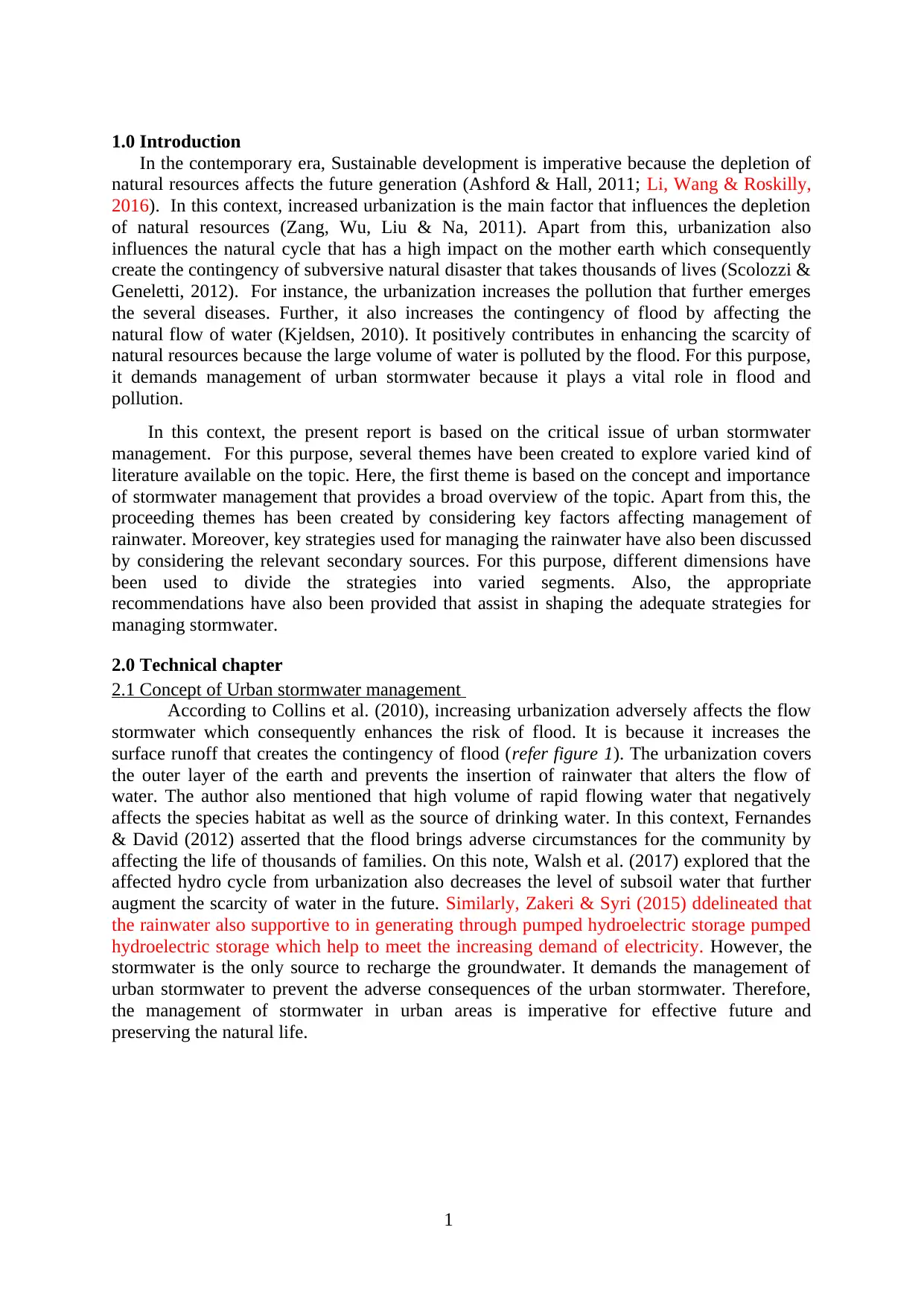
1.0 Introduction
In the contemporary era, Sustainable development is imperative because the depletion of
natural resources affects the future generation (Ashford & Hall, 2011; Li, Wang & Roskilly,
2016). In this context, increased urbanization is the main factor that influences the depletion
of natural resources (Zang, Wu, Liu & Na, 2011). Apart from this, urbanization also
influences the natural cycle that has a high impact on the mother earth which consequently
create the contingency of subversive natural disaster that takes thousands of lives (Scolozzi &
Geneletti, 2012). For instance, the urbanization increases the pollution that further emerges
the several diseases. Further, it also increases the contingency of flood by affecting the
natural flow of water (Kjeldsen, 2010). It positively contributes in enhancing the scarcity of
natural resources because the large volume of water is polluted by the flood. For this purpose,
it demands management of urban stormwater because it plays a vital role in flood and
pollution.
In this context, the present report is based on the critical issue of urban stormwater
management. For this purpose, several themes have been created to explore varied kind of
literature available on the topic. Here, the first theme is based on the concept and importance
of stormwater management that provides a broad overview of the topic. Apart from this, the
proceeding themes has been created by considering key factors affecting management of
rainwater. Moreover, key strategies used for managing the rainwater have also been discussed
by considering the relevant secondary sources. For this purpose, different dimensions have
been used to divide the strategies into varied segments. Also, the appropriate
recommendations have also been provided that assist in shaping the adequate strategies for
managing stormwater.
2.0 Technical chapter
2.1 Concept of Urban stormwater management
According to Collins et al. (2010), increasing urbanization adversely affects the flow
stormwater which consequently enhances the risk of flood. It is because it increases the
surface runoff that creates the contingency of flood (refer figure 1). The urbanization covers
the outer layer of the earth and prevents the insertion of rainwater that alters the flow of
water. The author also mentioned that high volume of rapid flowing water that negatively
affects the species habitat as well as the source of drinking water. In this context, Fernandes
& David (2012) asserted that the flood brings adverse circumstances for the community by
affecting the life of thousands of families. On this note, Walsh et al. (2017) explored that the
affected hydro cycle from urbanization also decreases the level of subsoil water that further
augment the scarcity of water in the future. Similarly, Zakeri & Syri (2015) ddelineated that
the rainwater also supportive to in generating through pumped hydroelectric storage pumped
hydroelectric storage which help to meet the increasing demand of electricity. However, the
stormwater is the only source to recharge the groundwater. It demands the management of
urban stormwater to prevent the adverse consequences of the urban stormwater. Therefore,
the management of stormwater in urban areas is imperative for effective future and
preserving the natural life.
1
In the contemporary era, Sustainable development is imperative because the depletion of
natural resources affects the future generation (Ashford & Hall, 2011; Li, Wang & Roskilly,
2016). In this context, increased urbanization is the main factor that influences the depletion
of natural resources (Zang, Wu, Liu & Na, 2011). Apart from this, urbanization also
influences the natural cycle that has a high impact on the mother earth which consequently
create the contingency of subversive natural disaster that takes thousands of lives (Scolozzi &
Geneletti, 2012). For instance, the urbanization increases the pollution that further emerges
the several diseases. Further, it also increases the contingency of flood by affecting the
natural flow of water (Kjeldsen, 2010). It positively contributes in enhancing the scarcity of
natural resources because the large volume of water is polluted by the flood. For this purpose,
it demands management of urban stormwater because it plays a vital role in flood and
pollution.
In this context, the present report is based on the critical issue of urban stormwater
management. For this purpose, several themes have been created to explore varied kind of
literature available on the topic. Here, the first theme is based on the concept and importance
of stormwater management that provides a broad overview of the topic. Apart from this, the
proceeding themes has been created by considering key factors affecting management of
rainwater. Moreover, key strategies used for managing the rainwater have also been discussed
by considering the relevant secondary sources. For this purpose, different dimensions have
been used to divide the strategies into varied segments. Also, the appropriate
recommendations have also been provided that assist in shaping the adequate strategies for
managing stormwater.
2.0 Technical chapter
2.1 Concept of Urban stormwater management
According to Collins et al. (2010), increasing urbanization adversely affects the flow
stormwater which consequently enhances the risk of flood. It is because it increases the
surface runoff that creates the contingency of flood (refer figure 1). The urbanization covers
the outer layer of the earth and prevents the insertion of rainwater that alters the flow of
water. The author also mentioned that high volume of rapid flowing water that negatively
affects the species habitat as well as the source of drinking water. In this context, Fernandes
& David (2012) asserted that the flood brings adverse circumstances for the community by
affecting the life of thousands of families. On this note, Walsh et al. (2017) explored that the
affected hydro cycle from urbanization also decreases the level of subsoil water that further
augment the scarcity of water in the future. Similarly, Zakeri & Syri (2015) ddelineated that
the rainwater also supportive to in generating through pumped hydroelectric storage pumped
hydroelectric storage which help to meet the increasing demand of electricity. However, the
stormwater is the only source to recharge the groundwater. It demands the management of
urban stormwater to prevent the adverse consequences of the urban stormwater. Therefore,
the management of stormwater in urban areas is imperative for effective future and
preserving the natural life.
1
⊘ This is a preview!⊘
Do you want full access?
Subscribe today to unlock all pages.

Trusted by 1+ million students worldwide
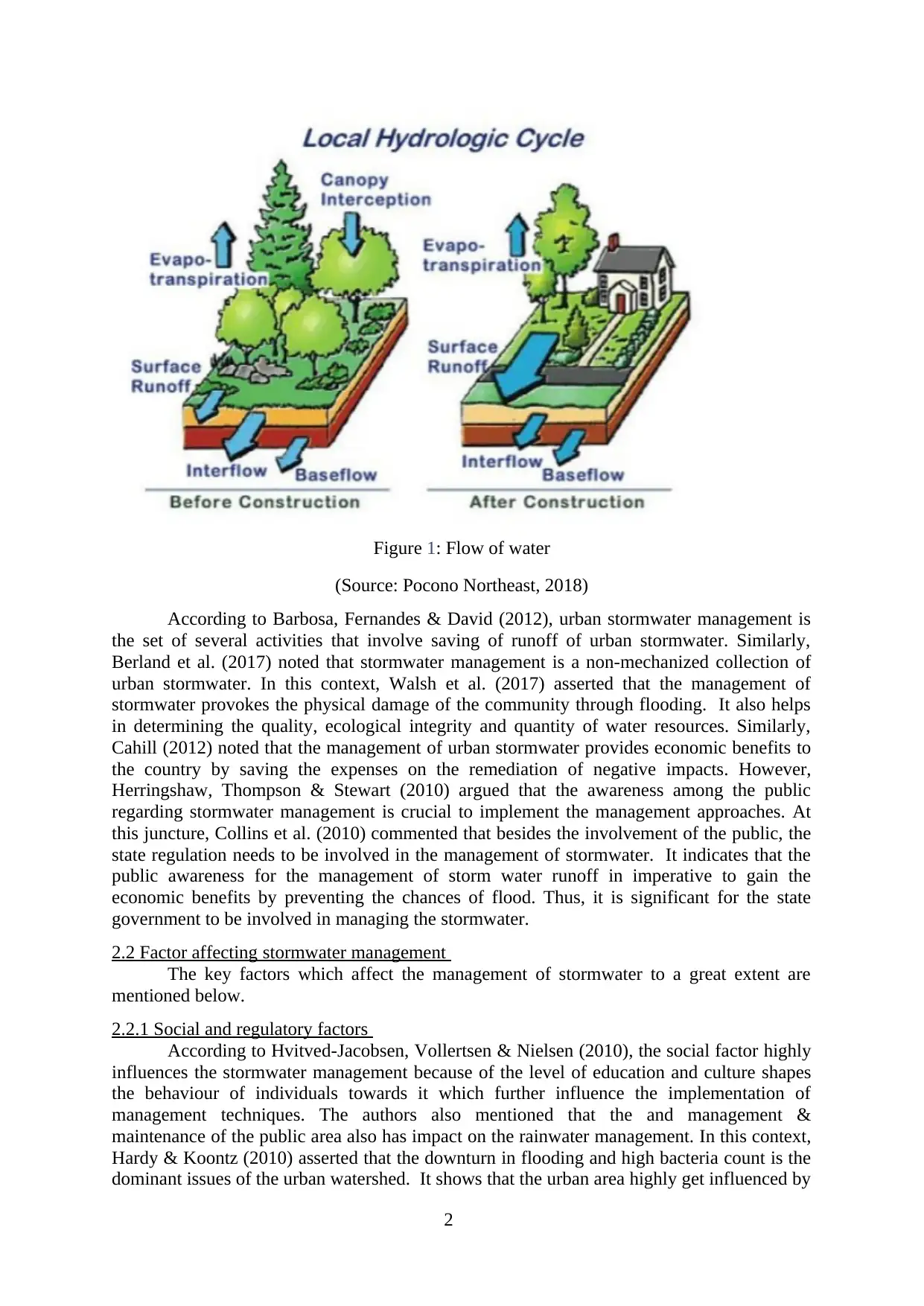
Figure 1: Flow of water
(Source: Pocono Northeast, 2018)
According to Barbosa, Fernandes & David (2012), urban stormwater management is
the set of several activities that involve saving of runoff of urban stormwater. Similarly,
Berland et al. (2017) noted that stormwater management is a non-mechanized collection of
urban stormwater. In this context, Walsh et al. (2017) asserted that the management of
stormwater provokes the physical damage of the community through flooding. It also helps
in determining the quality, ecological integrity and quantity of water resources. Similarly,
Cahill (2012) noted that the management of urban stormwater provides economic benefits to
the country by saving the expenses on the remediation of negative impacts. However,
Herringshaw, Thompson & Stewart (2010) argued that the awareness among the public
regarding stormwater management is crucial to implement the management approaches. At
this juncture, Collins et al. (2010) commented that besides the involvement of the public, the
state regulation needs to be involved in the management of stormwater. It indicates that the
public awareness for the management of storm water runoff in imperative to gain the
economic benefits by preventing the chances of flood. Thus, it is significant for the state
government to be involved in managing the stormwater.
2.2 Factor affecting stormwater management
The key factors which affect the management of stormwater to a great extent are
mentioned below.
2.2.1 Social and regulatory factors
According to Hvitved-Jacobsen, Vollertsen & Nielsen (2010), the social factor highly
influences the stormwater management because of the level of education and culture shapes
the behaviour of individuals towards it which further influence the implementation of
management techniques. The authors also mentioned that the and management &
maintenance of the public area also has impact on the rainwater management. In this context,
Hardy & Koontz (2010) asserted that the downturn in flooding and high bacteria count is the
dominant issues of the urban watershed. It shows that the urban area highly get influenced by
2
(Source: Pocono Northeast, 2018)
According to Barbosa, Fernandes & David (2012), urban stormwater management is
the set of several activities that involve saving of runoff of urban stormwater. Similarly,
Berland et al. (2017) noted that stormwater management is a non-mechanized collection of
urban stormwater. In this context, Walsh et al. (2017) asserted that the management of
stormwater provokes the physical damage of the community through flooding. It also helps
in determining the quality, ecological integrity and quantity of water resources. Similarly,
Cahill (2012) noted that the management of urban stormwater provides economic benefits to
the country by saving the expenses on the remediation of negative impacts. However,
Herringshaw, Thompson & Stewart (2010) argued that the awareness among the public
regarding stormwater management is crucial to implement the management approaches. At
this juncture, Collins et al. (2010) commented that besides the involvement of the public, the
state regulation needs to be involved in the management of stormwater. It indicates that the
public awareness for the management of storm water runoff in imperative to gain the
economic benefits by preventing the chances of flood. Thus, it is significant for the state
government to be involved in managing the stormwater.
2.2 Factor affecting stormwater management
The key factors which affect the management of stormwater to a great extent are
mentioned below.
2.2.1 Social and regulatory factors
According to Hvitved-Jacobsen, Vollertsen & Nielsen (2010), the social factor highly
influences the stormwater management because of the level of education and culture shapes
the behaviour of individuals towards it which further influence the implementation of
management techniques. The authors also mentioned that the and management &
maintenance of the public area also has impact on the rainwater management. In this context,
Hardy & Koontz (2010) asserted that the downturn in flooding and high bacteria count is the
dominant issues of the urban watershed. It shows that the urban area highly get influenced by
2
Paraphrase This Document
Need a fresh take? Get an instant paraphrase of this document with our AI Paraphraser
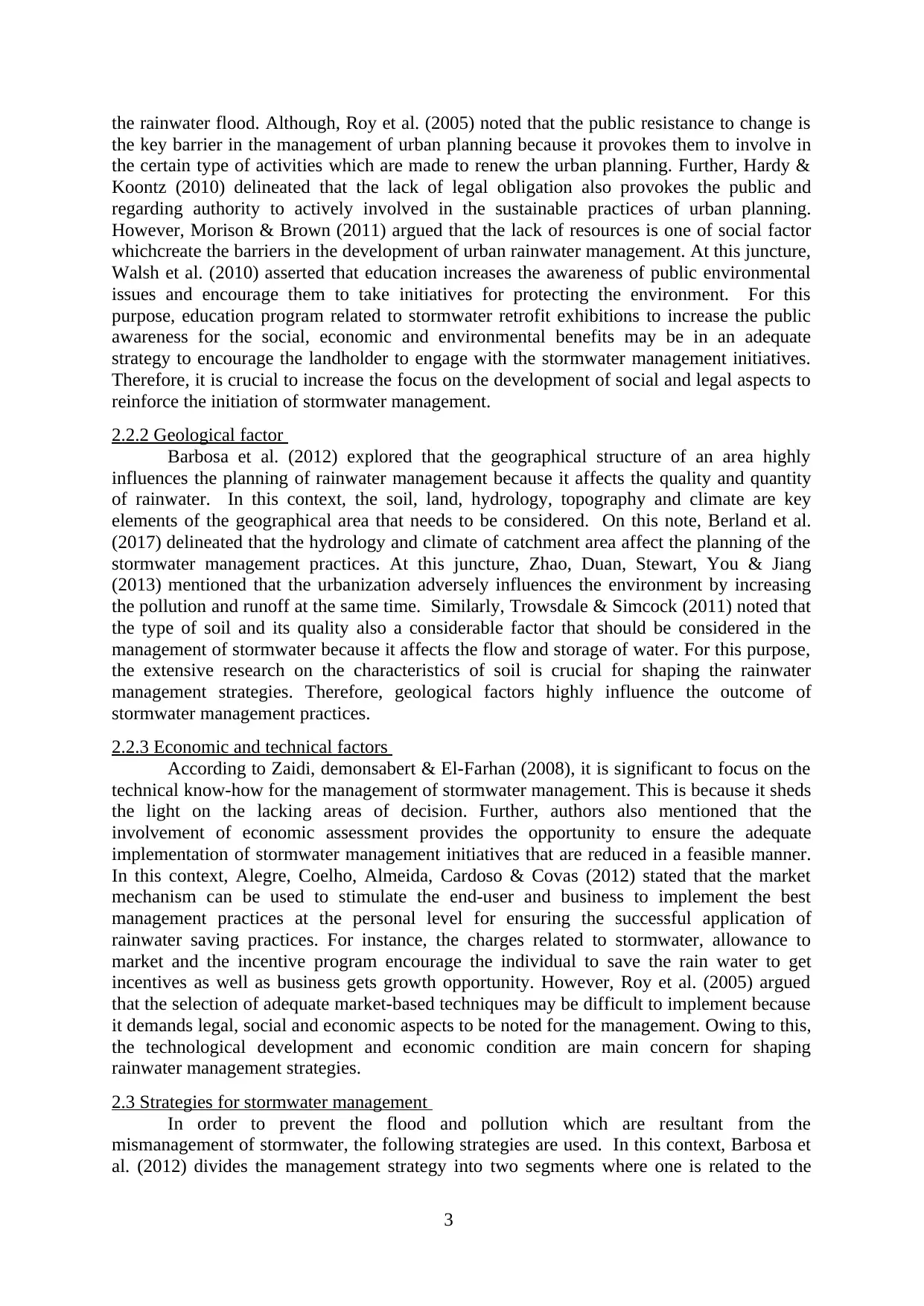
the rainwater flood. Although, Roy et al. (2005) noted that the public resistance to change is
the key barrier in the management of urban planning because it provokes them to involve in
the certain type of activities which are made to renew the urban planning. Further, Hardy &
Koontz (2010) delineated that the lack of legal obligation also provokes the public and
regarding authority to actively involved in the sustainable practices of urban planning.
However, Morison & Brown (2011) argued that the lack of resources is one of social factor
whichcreate the barriers in the development of urban rainwater management. At this juncture,
Walsh et al. (2010) asserted that education increases the awareness of public environmental
issues and encourage them to take initiatives for protecting the environment. For this
purpose, education program related to stormwater retrofit exhibitions to increase the public
awareness for the social, economic and environmental benefits may be in an adequate
strategy to encourage the landholder to engage with the stormwater management initiatives.
Therefore, it is crucial to increase the focus on the development of social and legal aspects to
reinforce the initiation of stormwater management.
2.2.2 Geological factor
Barbosa et al. (2012) explored that the geographical structure of an area highly
influences the planning of rainwater management because it affects the quality and quantity
of rainwater. In this context, the soil, land, hydrology, topography and climate are key
elements of the geographical area that needs to be considered. On this note, Berland et al.
(2017) delineated that the hydrology and climate of catchment area affect the planning of the
stormwater management practices. At this juncture, Zhao, Duan, Stewart, You & Jiang
(2013) mentioned that the urbanization adversely influences the environment by increasing
the pollution and runoff at the same time. Similarly, Trowsdale & Simcock (2011) noted that
the type of soil and its quality also a considerable factor that should be considered in the
management of stormwater because it affects the flow and storage of water. For this purpose,
the extensive research on the characteristics of soil is crucial for shaping the rainwater
management strategies. Therefore, geological factors highly influence the outcome of
stormwater management practices.
2.2.3 Economic and technical factors
According to Zaidi, demonsabert & El-Farhan (2008), it is significant to focus on the
technical know-how for the management of stormwater management. This is because it sheds
the light on the lacking areas of decision. Further, authors also mentioned that the
involvement of economic assessment provides the opportunity to ensure the adequate
implementation of stormwater management initiatives that are reduced in a feasible manner.
In this context, Alegre, Coelho, Almeida, Cardoso & Covas (2012) stated that the market
mechanism can be used to stimulate the end-user and business to implement the best
management practices at the personal level for ensuring the successful application of
rainwater saving practices. For instance, the charges related to stormwater, allowance to
market and the incentive program encourage the individual to save the rain water to get
incentives as well as business gets growth opportunity. However, Roy et al. (2005) argued
that the selection of adequate market-based techniques may be difficult to implement because
it demands legal, social and economic aspects to be noted for the management. Owing to this,
the technological development and economic condition are main concern for shaping
rainwater management strategies.
2.3 Strategies for stormwater management
In order to prevent the flood and pollution which are resultant from the
mismanagement of stormwater, the following strategies are used. In this context, Barbosa et
al. (2012) divides the management strategy into two segments where one is related to the
3
the key barrier in the management of urban planning because it provokes them to involve in
the certain type of activities which are made to renew the urban planning. Further, Hardy &
Koontz (2010) delineated that the lack of legal obligation also provokes the public and
regarding authority to actively involved in the sustainable practices of urban planning.
However, Morison & Brown (2011) argued that the lack of resources is one of social factor
whichcreate the barriers in the development of urban rainwater management. At this juncture,
Walsh et al. (2010) asserted that education increases the awareness of public environmental
issues and encourage them to take initiatives for protecting the environment. For this
purpose, education program related to stormwater retrofit exhibitions to increase the public
awareness for the social, economic and environmental benefits may be in an adequate
strategy to encourage the landholder to engage with the stormwater management initiatives.
Therefore, it is crucial to increase the focus on the development of social and legal aspects to
reinforce the initiation of stormwater management.
2.2.2 Geological factor
Barbosa et al. (2012) explored that the geographical structure of an area highly
influences the planning of rainwater management because it affects the quality and quantity
of rainwater. In this context, the soil, land, hydrology, topography and climate are key
elements of the geographical area that needs to be considered. On this note, Berland et al.
(2017) delineated that the hydrology and climate of catchment area affect the planning of the
stormwater management practices. At this juncture, Zhao, Duan, Stewart, You & Jiang
(2013) mentioned that the urbanization adversely influences the environment by increasing
the pollution and runoff at the same time. Similarly, Trowsdale & Simcock (2011) noted that
the type of soil and its quality also a considerable factor that should be considered in the
management of stormwater because it affects the flow and storage of water. For this purpose,
the extensive research on the characteristics of soil is crucial for shaping the rainwater
management strategies. Therefore, geological factors highly influence the outcome of
stormwater management practices.
2.2.3 Economic and technical factors
According to Zaidi, demonsabert & El-Farhan (2008), it is significant to focus on the
technical know-how for the management of stormwater management. This is because it sheds
the light on the lacking areas of decision. Further, authors also mentioned that the
involvement of economic assessment provides the opportunity to ensure the adequate
implementation of stormwater management initiatives that are reduced in a feasible manner.
In this context, Alegre, Coelho, Almeida, Cardoso & Covas (2012) stated that the market
mechanism can be used to stimulate the end-user and business to implement the best
management practices at the personal level for ensuring the successful application of
rainwater saving practices. For instance, the charges related to stormwater, allowance to
market and the incentive program encourage the individual to save the rain water to get
incentives as well as business gets growth opportunity. However, Roy et al. (2005) argued
that the selection of adequate market-based techniques may be difficult to implement because
it demands legal, social and economic aspects to be noted for the management. Owing to this,
the technological development and economic condition are main concern for shaping
rainwater management strategies.
2.3 Strategies for stormwater management
In order to prevent the flood and pollution which are resultant from the
mismanagement of stormwater, the following strategies are used. In this context, Barbosa et
al. (2012) divides the management strategy into two segments where one is related to the
3
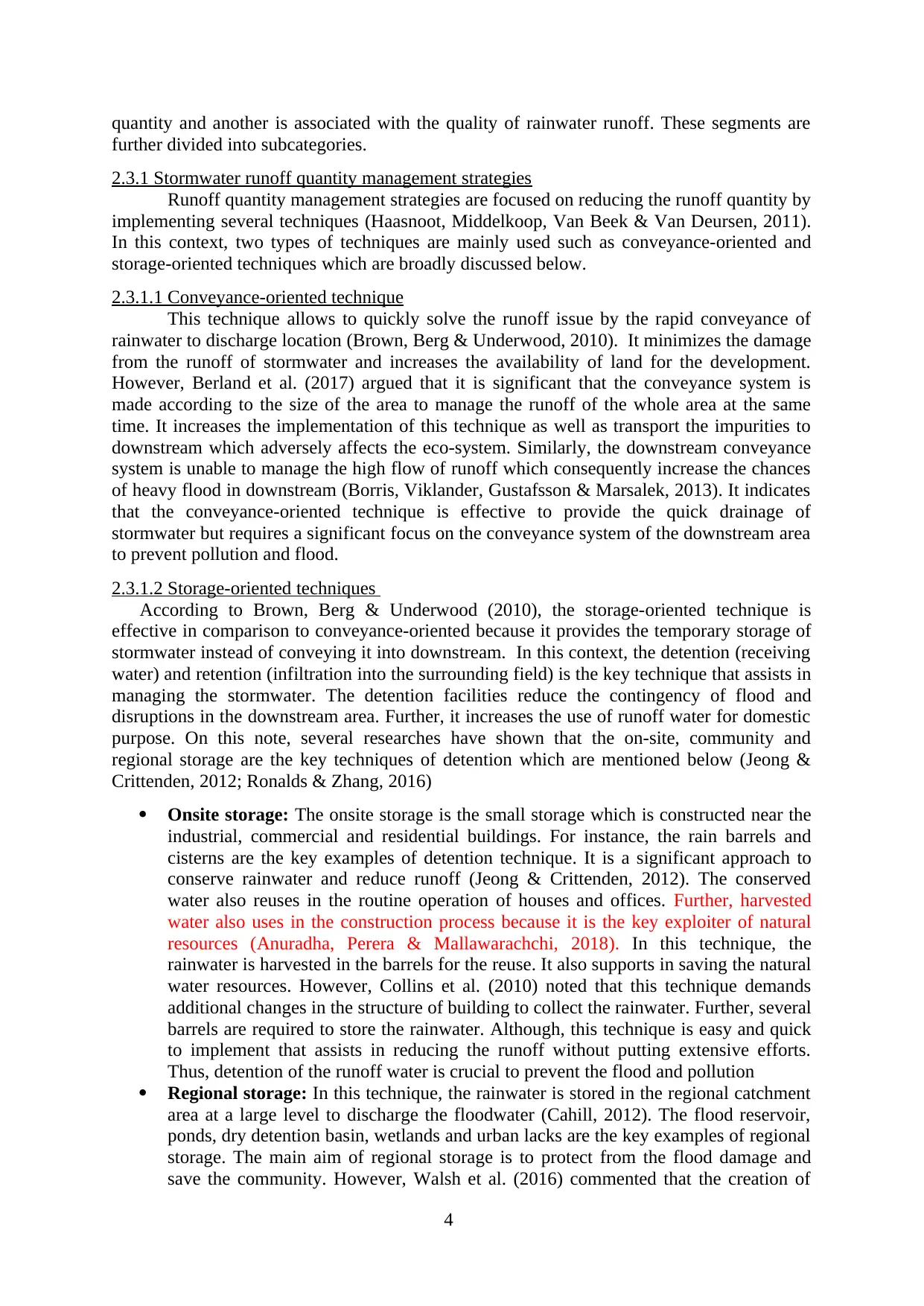
quantity and another is associated with the quality of rainwater runoff. These segments are
further divided into subcategories.
2.3.1 Stormwater runoff quantity management strategies
Runoff quantity management strategies are focused on reducing the runoff quantity by
implementing several techniques (Haasnoot, Middelkoop, Van Beek & Van Deursen, 2011).
In this context, two types of techniques are mainly used such as conveyance-oriented and
storage-oriented techniques which are broadly discussed below.
2.3.1.1 Conveyance-oriented technique
This technique allows to quickly solve the runoff issue by the rapid conveyance of
rainwater to discharge location (Brown, Berg & Underwood, 2010). It minimizes the damage
from the runoff of stormwater and increases the availability of land for the development.
However, Berland et al. (2017) argued that it is significant that the conveyance system is
made according to the size of the area to manage the runoff of the whole area at the same
time. It increases the implementation of this technique as well as transport the impurities to
downstream which adversely affects the eco-system. Similarly, the downstream conveyance
system is unable to manage the high flow of runoff which consequently increase the chances
of heavy flood in downstream (Borris, Viklander, Gustafsson & Marsalek, 2013). It indicates
that the conveyance-oriented technique is effective to provide the quick drainage of
stormwater but requires a significant focus on the conveyance system of the downstream area
to prevent pollution and flood.
2.3.1.2 Storage-oriented techniques
According to Brown, Berg & Underwood (2010), the storage-oriented technique is
effective in comparison to conveyance-oriented because it provides the temporary storage of
stormwater instead of conveying it into downstream. In this context, the detention (receiving
water) and retention (infiltration into the surrounding field) is the key technique that assists in
managing the stormwater. The detention facilities reduce the contingency of flood and
disruptions in the downstream area. Further, it increases the use of runoff water for domestic
purpose. On this note, several researches have shown that the on-site, community and
regional storage are the key techniques of detention which are mentioned below (Jeong &
Crittenden, 2012; Ronalds & Zhang, 2016)
Onsite storage: The onsite storage is the small storage which is constructed near the
industrial, commercial and residential buildings. For instance, the rain barrels and
cisterns are the key examples of detention technique. It is a significant approach to
conserve rainwater and reduce runoff (Jeong & Crittenden, 2012). The conserved
water also reuses in the routine operation of houses and offices. Further, harvested
water also uses in the construction process because it is the key exploiter of natural
resources (Anuradha, Perera & Mallawarachchi, 2018). In this technique, the
rainwater is harvested in the barrels for the reuse. It also supports in saving the natural
water resources. However, Collins et al. (2010) noted that this technique demands
additional changes in the structure of building to collect the rainwater. Further, several
barrels are required to store the rainwater. Although, this technique is easy and quick
to implement that assists in reducing the runoff without putting extensive efforts.
Thus, detention of the runoff water is crucial to prevent the flood and pollution
Regional storage: In this technique, the rainwater is stored in the regional catchment
area at a large level to discharge the floodwater (Cahill, 2012). The flood reservoir,
ponds, dry detention basin, wetlands and urban lacks are the key examples of regional
storage. The main aim of regional storage is to protect from the flood damage and
save the community. However, Walsh et al. (2016) commented that the creation of
4
further divided into subcategories.
2.3.1 Stormwater runoff quantity management strategies
Runoff quantity management strategies are focused on reducing the runoff quantity by
implementing several techniques (Haasnoot, Middelkoop, Van Beek & Van Deursen, 2011).
In this context, two types of techniques are mainly used such as conveyance-oriented and
storage-oriented techniques which are broadly discussed below.
2.3.1.1 Conveyance-oriented technique
This technique allows to quickly solve the runoff issue by the rapid conveyance of
rainwater to discharge location (Brown, Berg & Underwood, 2010). It minimizes the damage
from the runoff of stormwater and increases the availability of land for the development.
However, Berland et al. (2017) argued that it is significant that the conveyance system is
made according to the size of the area to manage the runoff of the whole area at the same
time. It increases the implementation of this technique as well as transport the impurities to
downstream which adversely affects the eco-system. Similarly, the downstream conveyance
system is unable to manage the high flow of runoff which consequently increase the chances
of heavy flood in downstream (Borris, Viklander, Gustafsson & Marsalek, 2013). It indicates
that the conveyance-oriented technique is effective to provide the quick drainage of
stormwater but requires a significant focus on the conveyance system of the downstream area
to prevent pollution and flood.
2.3.1.2 Storage-oriented techniques
According to Brown, Berg & Underwood (2010), the storage-oriented technique is
effective in comparison to conveyance-oriented because it provides the temporary storage of
stormwater instead of conveying it into downstream. In this context, the detention (receiving
water) and retention (infiltration into the surrounding field) is the key technique that assists in
managing the stormwater. The detention facilities reduce the contingency of flood and
disruptions in the downstream area. Further, it increases the use of runoff water for domestic
purpose. On this note, several researches have shown that the on-site, community and
regional storage are the key techniques of detention which are mentioned below (Jeong &
Crittenden, 2012; Ronalds & Zhang, 2016)
Onsite storage: The onsite storage is the small storage which is constructed near the
industrial, commercial and residential buildings. For instance, the rain barrels and
cisterns are the key examples of detention technique. It is a significant approach to
conserve rainwater and reduce runoff (Jeong & Crittenden, 2012). The conserved
water also reuses in the routine operation of houses and offices. Further, harvested
water also uses in the construction process because it is the key exploiter of natural
resources (Anuradha, Perera & Mallawarachchi, 2018). In this technique, the
rainwater is harvested in the barrels for the reuse. It also supports in saving the natural
water resources. However, Collins et al. (2010) noted that this technique demands
additional changes in the structure of building to collect the rainwater. Further, several
barrels are required to store the rainwater. Although, this technique is easy and quick
to implement that assists in reducing the runoff without putting extensive efforts.
Thus, detention of the runoff water is crucial to prevent the flood and pollution
Regional storage: In this technique, the rainwater is stored in the regional catchment
area at a large level to discharge the floodwater (Cahill, 2012). The flood reservoir,
ponds, dry detention basin, wetlands and urban lacks are the key examples of regional
storage. The main aim of regional storage is to protect from the flood damage and
save the community. However, Walsh et al. (2016) commented that the creation of
4
⊘ This is a preview!⊘
Do you want full access?
Subscribe today to unlock all pages.

Trusted by 1+ million students worldwide
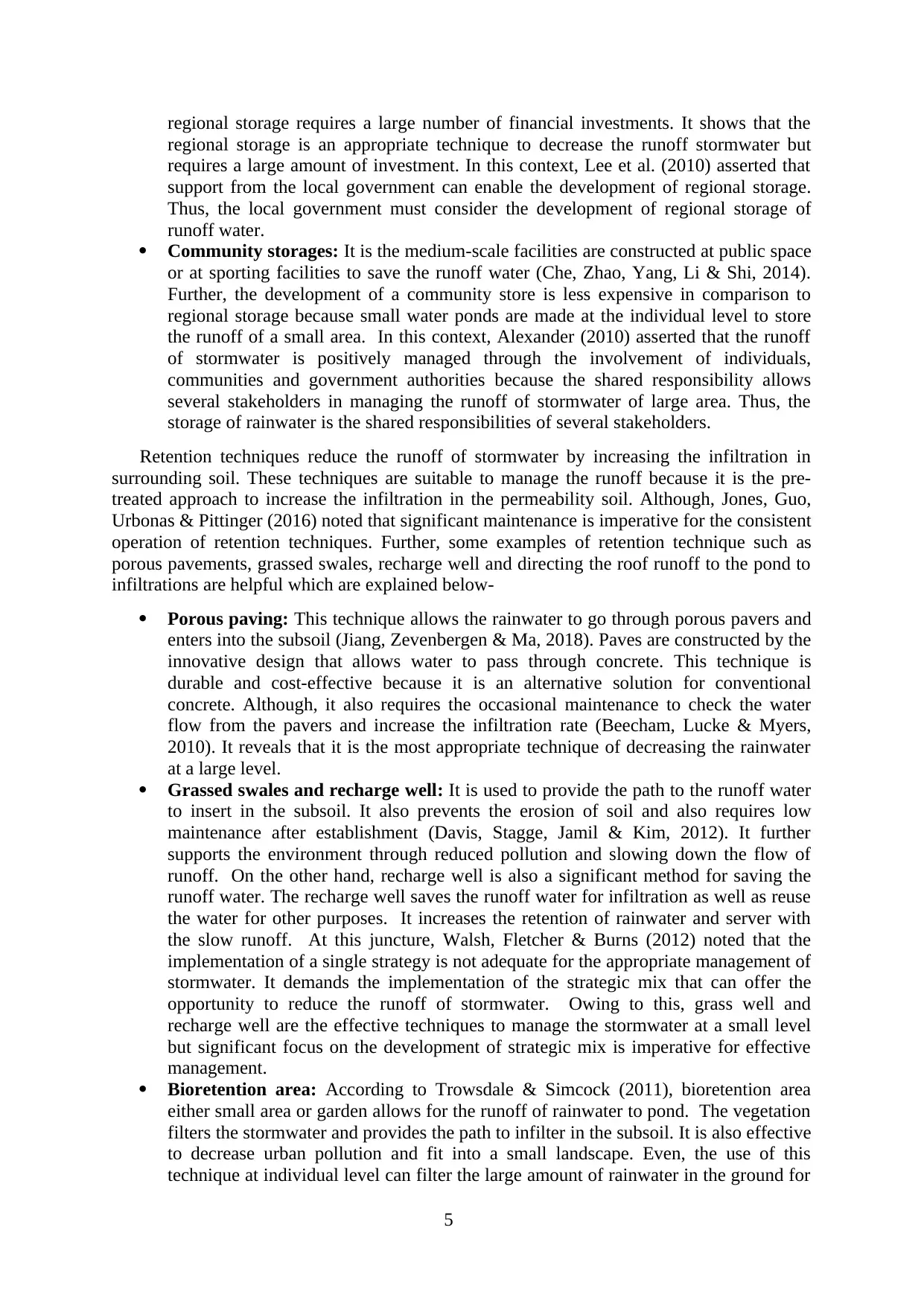
regional storage requires a large number of financial investments. It shows that the
regional storage is an appropriate technique to decrease the runoff stormwater but
requires a large amount of investment. In this context, Lee et al. (2010) asserted that
support from the local government can enable the development of regional storage.
Thus, the local government must consider the development of regional storage of
runoff water.
Community storages: It is the medium-scale facilities are constructed at public space
or at sporting facilities to save the runoff water (Che, Zhao, Yang, Li & Shi, 2014).
Further, the development of a community store is less expensive in comparison to
regional storage because small water ponds are made at the individual level to store
the runoff of a small area. In this context, Alexander (2010) asserted that the runoff
of stormwater is positively managed through the involvement of individuals,
communities and government authorities because the shared responsibility allows
several stakeholders in managing the runoff of stormwater of large area. Thus, the
storage of rainwater is the shared responsibilities of several stakeholders.
Retention techniques reduce the runoff of stormwater by increasing the infiltration in
surrounding soil. These techniques are suitable to manage the runoff because it is the pre-
treated approach to increase the infiltration in the permeability soil. Although, Jones, Guo,
Urbonas & Pittinger (2016) noted that significant maintenance is imperative for the consistent
operation of retention techniques. Further, some examples of retention technique such as
porous pavements, grassed swales, recharge well and directing the roof runoff to the pond to
infiltrations are helpful which are explained below-
Porous paving: This technique allows the rainwater to go through porous pavers and
enters into the subsoil (Jiang, Zevenbergen & Ma, 2018). Paves are constructed by the
innovative design that allows water to pass through concrete. This technique is
durable and cost-effective because it is an alternative solution for conventional
concrete. Although, it also requires the occasional maintenance to check the water
flow from the pavers and increase the infiltration rate (Beecham, Lucke & Myers,
2010). It reveals that it is the most appropriate technique of decreasing the rainwater
at a large level.
Grassed swales and recharge well: It is used to provide the path to the runoff water
to insert in the subsoil. It also prevents the erosion of soil and also requires low
maintenance after establishment (Davis, Stagge, Jamil & Kim, 2012). It further
supports the environment through reduced pollution and slowing down the flow of
runoff. On the other hand, recharge well is also a significant method for saving the
runoff water. The recharge well saves the runoff water for infiltration as well as reuse
the water for other purposes. It increases the retention of rainwater and server with
the slow runoff. At this juncture, Walsh, Fletcher & Burns (2012) noted that the
implementation of a single strategy is not adequate for the appropriate management of
stormwater. It demands the implementation of the strategic mix that can offer the
opportunity to reduce the runoff of stormwater. Owing to this, grass well and
recharge well are the effective techniques to manage the stormwater at a small level
but significant focus on the development of strategic mix is imperative for effective
management.
Bioretention area: According to Trowsdale & Simcock (2011), bioretention area
either small area or garden allows for the runoff of rainwater to pond. The vegetation
filters the stormwater and provides the path to infilter in the subsoil. It is also effective
to decrease urban pollution and fit into a small landscape. Even, the use of this
technique at individual level can filter the large amount of rainwater in the ground for
5
regional storage is an appropriate technique to decrease the runoff stormwater but
requires a large amount of investment. In this context, Lee et al. (2010) asserted that
support from the local government can enable the development of regional storage.
Thus, the local government must consider the development of regional storage of
runoff water.
Community storages: It is the medium-scale facilities are constructed at public space
or at sporting facilities to save the runoff water (Che, Zhao, Yang, Li & Shi, 2014).
Further, the development of a community store is less expensive in comparison to
regional storage because small water ponds are made at the individual level to store
the runoff of a small area. In this context, Alexander (2010) asserted that the runoff
of stormwater is positively managed through the involvement of individuals,
communities and government authorities because the shared responsibility allows
several stakeholders in managing the runoff of stormwater of large area. Thus, the
storage of rainwater is the shared responsibilities of several stakeholders.
Retention techniques reduce the runoff of stormwater by increasing the infiltration in
surrounding soil. These techniques are suitable to manage the runoff because it is the pre-
treated approach to increase the infiltration in the permeability soil. Although, Jones, Guo,
Urbonas & Pittinger (2016) noted that significant maintenance is imperative for the consistent
operation of retention techniques. Further, some examples of retention technique such as
porous pavements, grassed swales, recharge well and directing the roof runoff to the pond to
infiltrations are helpful which are explained below-
Porous paving: This technique allows the rainwater to go through porous pavers and
enters into the subsoil (Jiang, Zevenbergen & Ma, 2018). Paves are constructed by the
innovative design that allows water to pass through concrete. This technique is
durable and cost-effective because it is an alternative solution for conventional
concrete. Although, it also requires the occasional maintenance to check the water
flow from the pavers and increase the infiltration rate (Beecham, Lucke & Myers,
2010). It reveals that it is the most appropriate technique of decreasing the rainwater
at a large level.
Grassed swales and recharge well: It is used to provide the path to the runoff water
to insert in the subsoil. It also prevents the erosion of soil and also requires low
maintenance after establishment (Davis, Stagge, Jamil & Kim, 2012). It further
supports the environment through reduced pollution and slowing down the flow of
runoff. On the other hand, recharge well is also a significant method for saving the
runoff water. The recharge well saves the runoff water for infiltration as well as reuse
the water for other purposes. It increases the retention of rainwater and server with
the slow runoff. At this juncture, Walsh, Fletcher & Burns (2012) noted that the
implementation of a single strategy is not adequate for the appropriate management of
stormwater. It demands the implementation of the strategic mix that can offer the
opportunity to reduce the runoff of stormwater. Owing to this, grass well and
recharge well are the effective techniques to manage the stormwater at a small level
but significant focus on the development of strategic mix is imperative for effective
management.
Bioretention area: According to Trowsdale & Simcock (2011), bioretention area
either small area or garden allows for the runoff of rainwater to pond. The vegetation
filters the stormwater and provides the path to infilter in the subsoil. It is also effective
to decrease urban pollution and fit into a small landscape. Even, the use of this
technique at individual level can filter the large amount of rainwater in the ground for
5
Paraphrase This Document
Need a fresh take? Get an instant paraphrase of this document with our AI Paraphraser
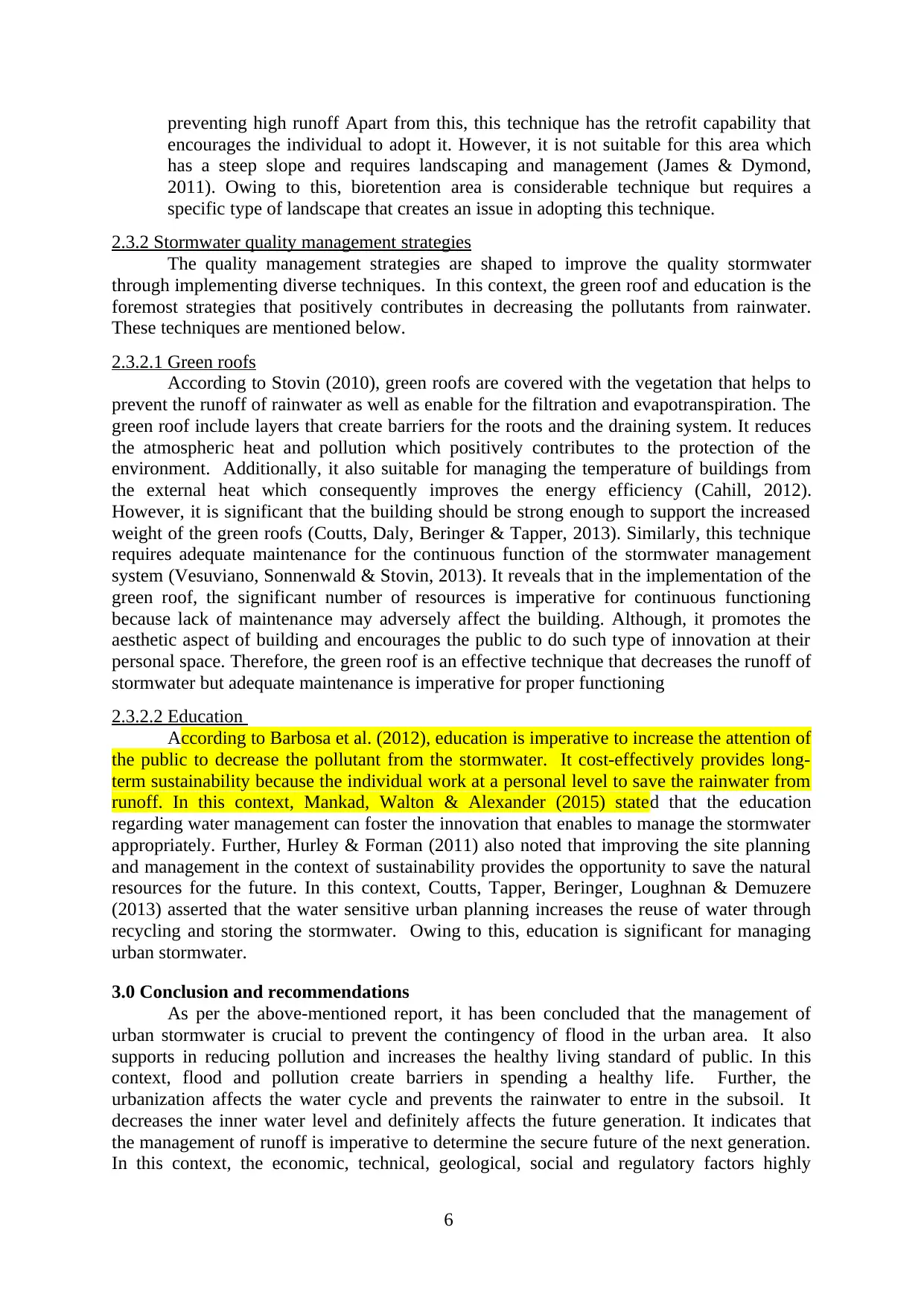
preventing high runoff Apart from this, this technique has the retrofit capability that
encourages the individual to adopt it. However, it is not suitable for this area which
has a steep slope and requires landscaping and management (James & Dymond,
2011). Owing to this, bioretention area is considerable technique but requires a
specific type of landscape that creates an issue in adopting this technique.
2.3.2 Stormwater quality management strategies
The quality management strategies are shaped to improve the quality stormwater
through implementing diverse techniques. In this context, the green roof and education is the
foremost strategies that positively contributes in decreasing the pollutants from rainwater.
These techniques are mentioned below.
2.3.2.1 Green roofs
According to Stovin (2010), green roofs are covered with the vegetation that helps to
prevent the runoff of rainwater as well as enable for the filtration and evapotranspiration. The
green roof include layers that create barriers for the roots and the draining system. It reduces
the atmospheric heat and pollution which positively contributes to the protection of the
environment. Additionally, it also suitable for managing the temperature of buildings from
the external heat which consequently improves the energy efficiency (Cahill, 2012).
However, it is significant that the building should be strong enough to support the increased
weight of the green roofs (Coutts, Daly, Beringer & Tapper, 2013). Similarly, this technique
requires adequate maintenance for the continuous function of the stormwater management
system (Vesuviano, Sonnenwald & Stovin, 2013). It reveals that in the implementation of the
green roof, the significant number of resources is imperative for continuous functioning
because lack of maintenance may adversely affect the building. Although, it promotes the
aesthetic aspect of building and encourages the public to do such type of innovation at their
personal space. Therefore, the green roof is an effective technique that decreases the runoff of
stormwater but adequate maintenance is imperative for proper functioning
2.3.2.2 Education
According to Barbosa et al. (2012), education is imperative to increase the attention of
the public to decrease the pollutant from the stormwater. It cost-effectively provides long-
term sustainability because the individual work at a personal level to save the rainwater from
runoff. In this context, Mankad, Walton & Alexander (2015) stated that the education
regarding water management can foster the innovation that enables to manage the stormwater
appropriately. Further, Hurley & Forman (2011) also noted that improving the site planning
and management in the context of sustainability provides the opportunity to save the natural
resources for the future. In this context, Coutts, Tapper, Beringer, Loughnan & Demuzere
(2013) asserted that the water sensitive urban planning increases the reuse of water through
recycling and storing the stormwater. Owing to this, education is significant for managing
urban stormwater.
3.0 Conclusion and recommendations
As per the above-mentioned report, it has been concluded that the management of
urban stormwater is crucial to prevent the contingency of flood in the urban area. It also
supports in reducing pollution and increases the healthy living standard of public. In this
context, flood and pollution create barriers in spending a healthy life. Further, the
urbanization affects the water cycle and prevents the rainwater to entre in the subsoil. It
decreases the inner water level and definitely affects the future generation. It indicates that
the management of runoff is imperative to determine the secure future of the next generation.
In this context, the economic, technical, geological, social and regulatory factors highly
6
encourages the individual to adopt it. However, it is not suitable for this area which
has a steep slope and requires landscaping and management (James & Dymond,
2011). Owing to this, bioretention area is considerable technique but requires a
specific type of landscape that creates an issue in adopting this technique.
2.3.2 Stormwater quality management strategies
The quality management strategies are shaped to improve the quality stormwater
through implementing diverse techniques. In this context, the green roof and education is the
foremost strategies that positively contributes in decreasing the pollutants from rainwater.
These techniques are mentioned below.
2.3.2.1 Green roofs
According to Stovin (2010), green roofs are covered with the vegetation that helps to
prevent the runoff of rainwater as well as enable for the filtration and evapotranspiration. The
green roof include layers that create barriers for the roots and the draining system. It reduces
the atmospheric heat and pollution which positively contributes to the protection of the
environment. Additionally, it also suitable for managing the temperature of buildings from
the external heat which consequently improves the energy efficiency (Cahill, 2012).
However, it is significant that the building should be strong enough to support the increased
weight of the green roofs (Coutts, Daly, Beringer & Tapper, 2013). Similarly, this technique
requires adequate maintenance for the continuous function of the stormwater management
system (Vesuviano, Sonnenwald & Stovin, 2013). It reveals that in the implementation of the
green roof, the significant number of resources is imperative for continuous functioning
because lack of maintenance may adversely affect the building. Although, it promotes the
aesthetic aspect of building and encourages the public to do such type of innovation at their
personal space. Therefore, the green roof is an effective technique that decreases the runoff of
stormwater but adequate maintenance is imperative for proper functioning
2.3.2.2 Education
According to Barbosa et al. (2012), education is imperative to increase the attention of
the public to decrease the pollutant from the stormwater. It cost-effectively provides long-
term sustainability because the individual work at a personal level to save the rainwater from
runoff. In this context, Mankad, Walton & Alexander (2015) stated that the education
regarding water management can foster the innovation that enables to manage the stormwater
appropriately. Further, Hurley & Forman (2011) also noted that improving the site planning
and management in the context of sustainability provides the opportunity to save the natural
resources for the future. In this context, Coutts, Tapper, Beringer, Loughnan & Demuzere
(2013) asserted that the water sensitive urban planning increases the reuse of water through
recycling and storing the stormwater. Owing to this, education is significant for managing
urban stormwater.
3.0 Conclusion and recommendations
As per the above-mentioned report, it has been concluded that the management of
urban stormwater is crucial to prevent the contingency of flood in the urban area. It also
supports in reducing pollution and increases the healthy living standard of public. In this
context, flood and pollution create barriers in spending a healthy life. Further, the
urbanization affects the water cycle and prevents the rainwater to entre in the subsoil. It
decreases the inner water level and definitely affects the future generation. It indicates that
the management of runoff is imperative to determine the secure future of the next generation.
In this context, the economic, technical, geological, social and regulatory factors highly
6
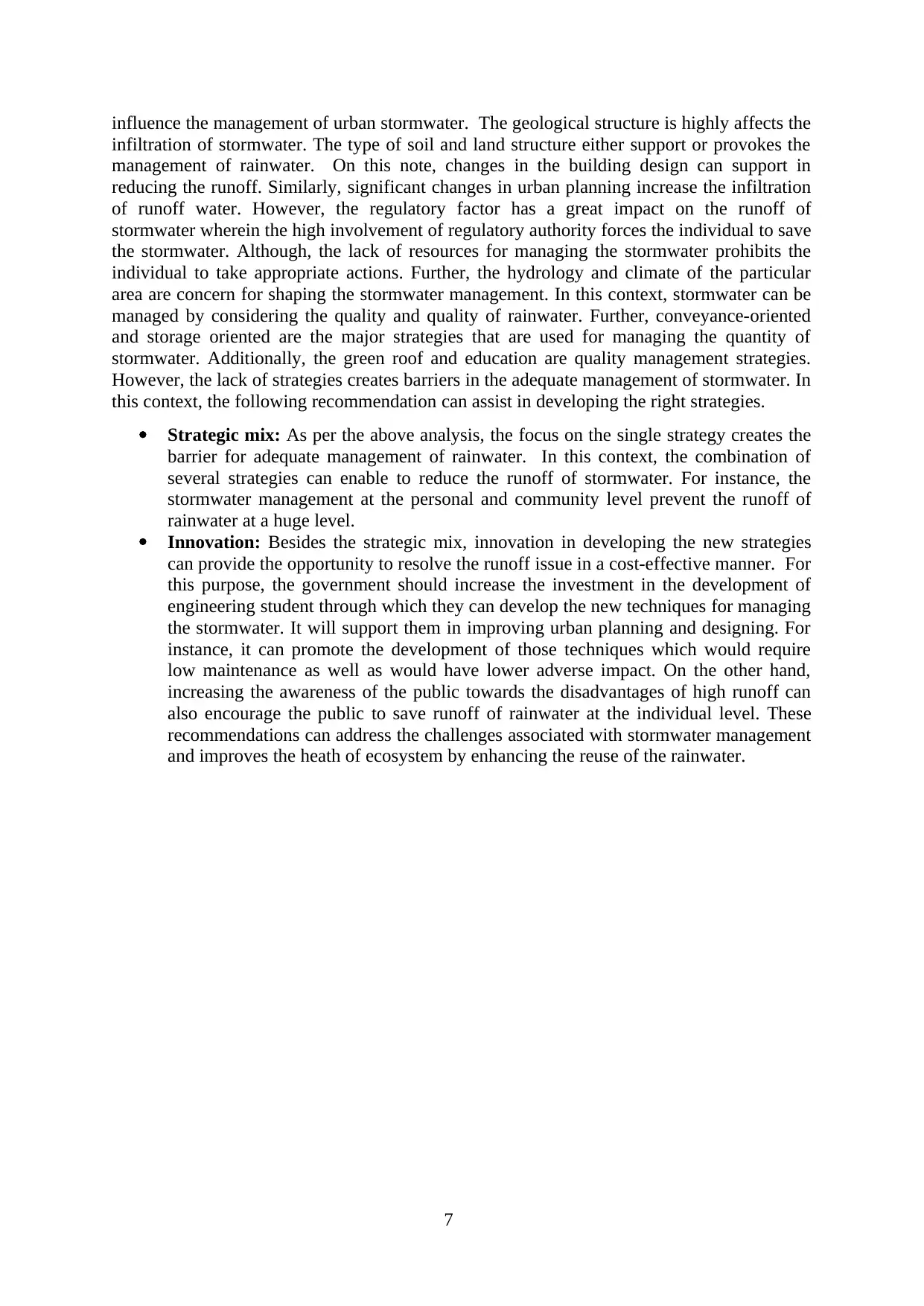
influence the management of urban stormwater. The geological structure is highly affects the
infiltration of stormwater. The type of soil and land structure either support or provokes the
management of rainwater. On this note, changes in the building design can support in
reducing the runoff. Similarly, significant changes in urban planning increase the infiltration
of runoff water. However, the regulatory factor has a great impact on the runoff of
stormwater wherein the high involvement of regulatory authority forces the individual to save
the stormwater. Although, the lack of resources for managing the stormwater prohibits the
individual to take appropriate actions. Further, the hydrology and climate of the particular
area are concern for shaping the stormwater management. In this context, stormwater can be
managed by considering the quality and quality of rainwater. Further, conveyance-oriented
and storage oriented are the major strategies that are used for managing the quantity of
stormwater. Additionally, the green roof and education are quality management strategies.
However, the lack of strategies creates barriers in the adequate management of stormwater. In
this context, the following recommendation can assist in developing the right strategies.
Strategic mix: As per the above analysis, the focus on the single strategy creates the
barrier for adequate management of rainwater. In this context, the combination of
several strategies can enable to reduce the runoff of stormwater. For instance, the
stormwater management at the personal and community level prevent the runoff of
rainwater at a huge level.
Innovation: Besides the strategic mix, innovation in developing the new strategies
can provide the opportunity to resolve the runoff issue in a cost-effective manner. For
this purpose, the government should increase the investment in the development of
engineering student through which they can develop the new techniques for managing
the stormwater. It will support them in improving urban planning and designing. For
instance, it can promote the development of those techniques which would require
low maintenance as well as would have lower adverse impact. On the other hand,
increasing the awareness of the public towards the disadvantages of high runoff can
also encourage the public to save runoff of rainwater at the individual level. These
recommendations can address the challenges associated with stormwater management
and improves the heath of ecosystem by enhancing the reuse of the rainwater.
7
infiltration of stormwater. The type of soil and land structure either support or provokes the
management of rainwater. On this note, changes in the building design can support in
reducing the runoff. Similarly, significant changes in urban planning increase the infiltration
of runoff water. However, the regulatory factor has a great impact on the runoff of
stormwater wherein the high involvement of regulatory authority forces the individual to save
the stormwater. Although, the lack of resources for managing the stormwater prohibits the
individual to take appropriate actions. Further, the hydrology and climate of the particular
area are concern for shaping the stormwater management. In this context, stormwater can be
managed by considering the quality and quality of rainwater. Further, conveyance-oriented
and storage oriented are the major strategies that are used for managing the quantity of
stormwater. Additionally, the green roof and education are quality management strategies.
However, the lack of strategies creates barriers in the adequate management of stormwater. In
this context, the following recommendation can assist in developing the right strategies.
Strategic mix: As per the above analysis, the focus on the single strategy creates the
barrier for adequate management of rainwater. In this context, the combination of
several strategies can enable to reduce the runoff of stormwater. For instance, the
stormwater management at the personal and community level prevent the runoff of
rainwater at a huge level.
Innovation: Besides the strategic mix, innovation in developing the new strategies
can provide the opportunity to resolve the runoff issue in a cost-effective manner. For
this purpose, the government should increase the investment in the development of
engineering student through which they can develop the new techniques for managing
the stormwater. It will support them in improving urban planning and designing. For
instance, it can promote the development of those techniques which would require
low maintenance as well as would have lower adverse impact. On the other hand,
increasing the awareness of the public towards the disadvantages of high runoff can
also encourage the public to save runoff of rainwater at the individual level. These
recommendations can address the challenges associated with stormwater management
and improves the heath of ecosystem by enhancing the reuse of the rainwater.
7
⊘ This is a preview!⊘
Do you want full access?
Subscribe today to unlock all pages.

Trusted by 1+ million students worldwide
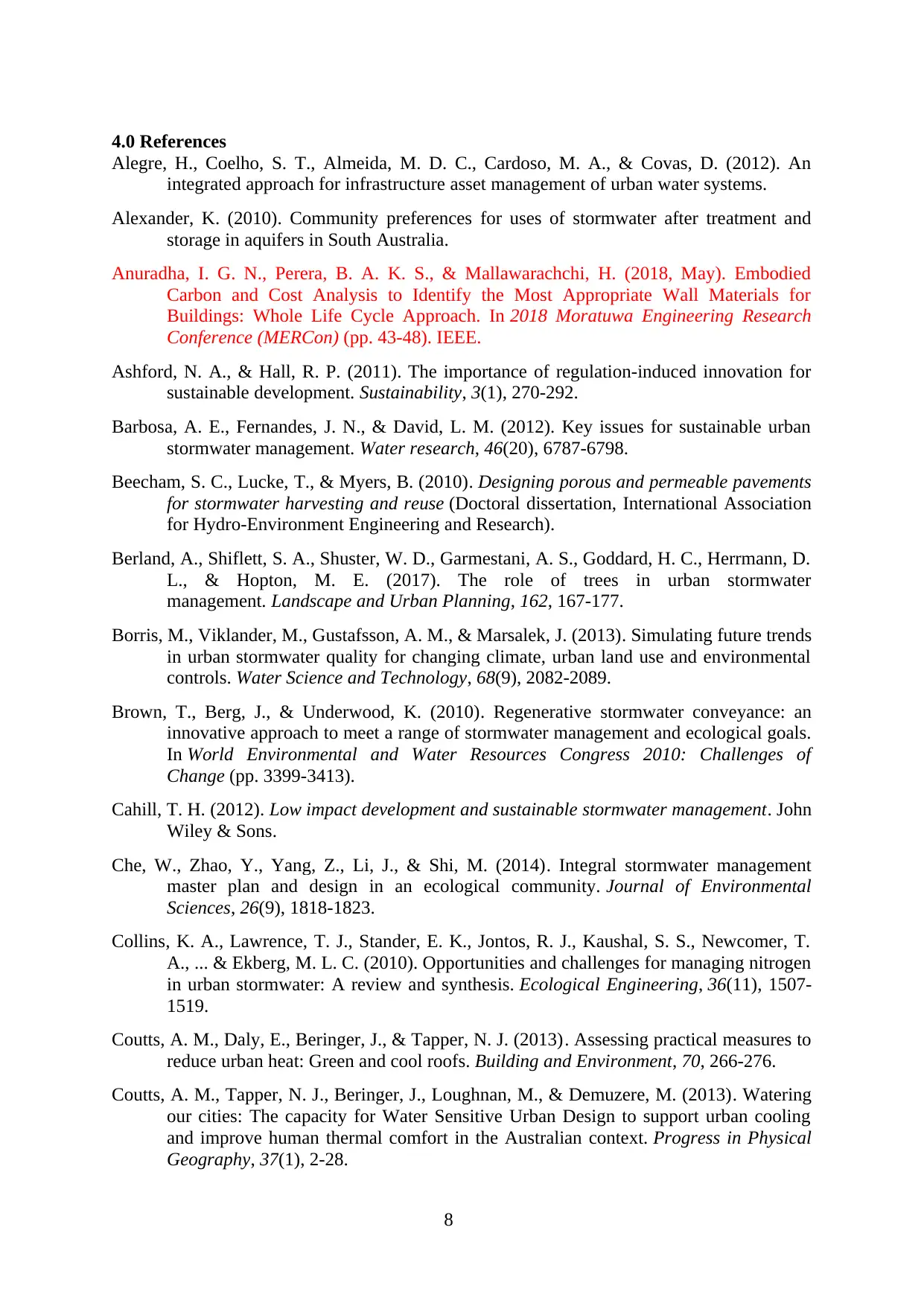
4.0 References
Alegre, H., Coelho, S. T., Almeida, M. D. C., Cardoso, M. A., & Covas, D. (2012). An
integrated approach for infrastructure asset management of urban water systems.
Alexander, K. (2010). Community preferences for uses of stormwater after treatment and
storage in aquifers in South Australia.
Anuradha, I. G. N., Perera, B. A. K. S., & Mallawarachchi, H. (2018, May). Embodied
Carbon and Cost Analysis to Identify the Most Appropriate Wall Materials for
Buildings: Whole Life Cycle Approach. In 2018 Moratuwa Engineering Research
Conference (MERCon) (pp. 43-48). IEEE.
Ashford, N. A., & Hall, R. P. (2011). The importance of regulation-induced innovation for
sustainable development. Sustainability, 3(1), 270-292.
Barbosa, A. E., Fernandes, J. N., & David, L. M. (2012). Key issues for sustainable urban
stormwater management. Water research, 46(20), 6787-6798.
Beecham, S. C., Lucke, T., & Myers, B. (2010). Designing porous and permeable pavements
for stormwater harvesting and reuse (Doctoral dissertation, International Association
for Hydro-Environment Engineering and Research).
Berland, A., Shiflett, S. A., Shuster, W. D., Garmestani, A. S., Goddard, H. C., Herrmann, D.
L., & Hopton, M. E. (2017). The role of trees in urban stormwater
management. Landscape and Urban Planning, 162, 167-177.
Borris, M., Viklander, M., Gustafsson, A. M., & Marsalek, J. (2013). Simulating future trends
in urban stormwater quality for changing climate, urban land use and environmental
controls. Water Science and Technology, 68(9), 2082-2089.
Brown, T., Berg, J., & Underwood, K. (2010). Regenerative stormwater conveyance: an
innovative approach to meet a range of stormwater management and ecological goals.
In World Environmental and Water Resources Congress 2010: Challenges of
Change (pp. 3399-3413).
Cahill, T. H. (2012). Low impact development and sustainable stormwater management. John
Wiley & Sons.
Che, W., Zhao, Y., Yang, Z., Li, J., & Shi, M. (2014). Integral stormwater management
master plan and design in an ecological community. Journal of Environmental
Sciences, 26(9), 1818-1823.
Collins, K. A., Lawrence, T. J., Stander, E. K., Jontos, R. J., Kaushal, S. S., Newcomer, T.
A., ... & Ekberg, M. L. C. (2010). Opportunities and challenges for managing nitrogen
in urban stormwater: A review and synthesis. Ecological Engineering, 36(11), 1507-
1519.
Coutts, A. M., Daly, E., Beringer, J., & Tapper, N. J. (2013). Assessing practical measures to
reduce urban heat: Green and cool roofs. Building and Environment, 70, 266-276.
Coutts, A. M., Tapper, N. J., Beringer, J., Loughnan, M., & Demuzere, M. (2013). Watering
our cities: The capacity for Water Sensitive Urban Design to support urban cooling
and improve human thermal comfort in the Australian context. Progress in Physical
Geography, 37(1), 2-28.
8
Alegre, H., Coelho, S. T., Almeida, M. D. C., Cardoso, M. A., & Covas, D. (2012). An
integrated approach for infrastructure asset management of urban water systems.
Alexander, K. (2010). Community preferences for uses of stormwater after treatment and
storage in aquifers in South Australia.
Anuradha, I. G. N., Perera, B. A. K. S., & Mallawarachchi, H. (2018, May). Embodied
Carbon and Cost Analysis to Identify the Most Appropriate Wall Materials for
Buildings: Whole Life Cycle Approach. In 2018 Moratuwa Engineering Research
Conference (MERCon) (pp. 43-48). IEEE.
Ashford, N. A., & Hall, R. P. (2011). The importance of regulation-induced innovation for
sustainable development. Sustainability, 3(1), 270-292.
Barbosa, A. E., Fernandes, J. N., & David, L. M. (2012). Key issues for sustainable urban
stormwater management. Water research, 46(20), 6787-6798.
Beecham, S. C., Lucke, T., & Myers, B. (2010). Designing porous and permeable pavements
for stormwater harvesting and reuse (Doctoral dissertation, International Association
for Hydro-Environment Engineering and Research).
Berland, A., Shiflett, S. A., Shuster, W. D., Garmestani, A. S., Goddard, H. C., Herrmann, D.
L., & Hopton, M. E. (2017). The role of trees in urban stormwater
management. Landscape and Urban Planning, 162, 167-177.
Borris, M., Viklander, M., Gustafsson, A. M., & Marsalek, J. (2013). Simulating future trends
in urban stormwater quality for changing climate, urban land use and environmental
controls. Water Science and Technology, 68(9), 2082-2089.
Brown, T., Berg, J., & Underwood, K. (2010). Regenerative stormwater conveyance: an
innovative approach to meet a range of stormwater management and ecological goals.
In World Environmental and Water Resources Congress 2010: Challenges of
Change (pp. 3399-3413).
Cahill, T. H. (2012). Low impact development and sustainable stormwater management. John
Wiley & Sons.
Che, W., Zhao, Y., Yang, Z., Li, J., & Shi, M. (2014). Integral stormwater management
master plan and design in an ecological community. Journal of Environmental
Sciences, 26(9), 1818-1823.
Collins, K. A., Lawrence, T. J., Stander, E. K., Jontos, R. J., Kaushal, S. S., Newcomer, T.
A., ... & Ekberg, M. L. C. (2010). Opportunities and challenges for managing nitrogen
in urban stormwater: A review and synthesis. Ecological Engineering, 36(11), 1507-
1519.
Coutts, A. M., Daly, E., Beringer, J., & Tapper, N. J. (2013). Assessing practical measures to
reduce urban heat: Green and cool roofs. Building and Environment, 70, 266-276.
Coutts, A. M., Tapper, N. J., Beringer, J., Loughnan, M., & Demuzere, M. (2013). Watering
our cities: The capacity for Water Sensitive Urban Design to support urban cooling
and improve human thermal comfort in the Australian context. Progress in Physical
Geography, 37(1), 2-28.
8
Paraphrase This Document
Need a fresh take? Get an instant paraphrase of this document with our AI Paraphraser
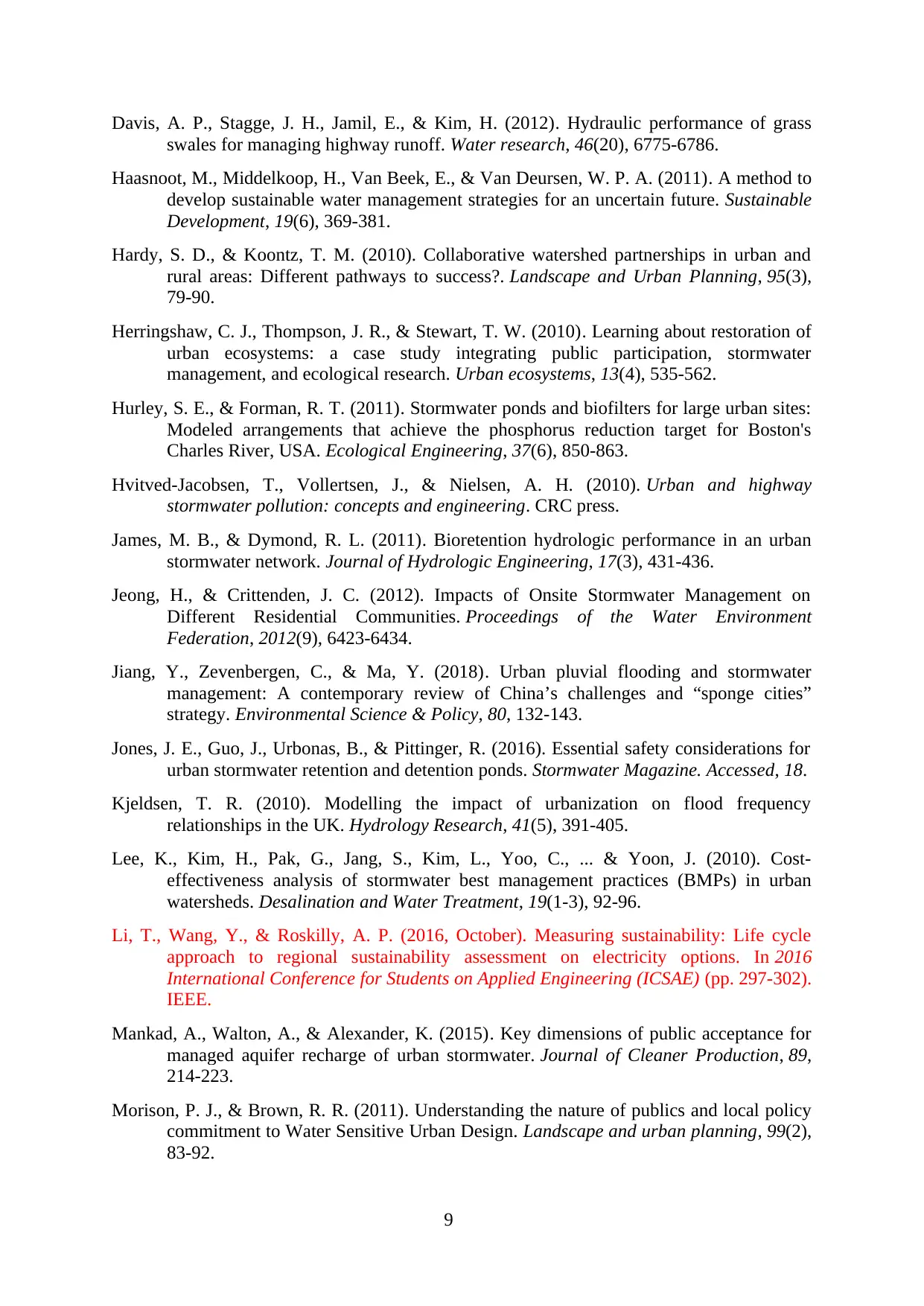
Davis, A. P., Stagge, J. H., Jamil, E., & Kim, H. (2012). Hydraulic performance of grass
swales for managing highway runoff. Water research, 46(20), 6775-6786.
Haasnoot, M., Middelkoop, H., Van Beek, E., & Van Deursen, W. P. A. (2011). A method to
develop sustainable water management strategies for an uncertain future. Sustainable
Development, 19(6), 369-381.
Hardy, S. D., & Koontz, T. M. (2010). Collaborative watershed partnerships in urban and
rural areas: Different pathways to success?. Landscape and Urban Planning, 95(3),
79-90.
Herringshaw, C. J., Thompson, J. R., & Stewart, T. W. (2010). Learning about restoration of
urban ecosystems: a case study integrating public participation, stormwater
management, and ecological research. Urban ecosystems, 13(4), 535-562.
Hurley, S. E., & Forman, R. T. (2011). Stormwater ponds and biofilters for large urban sites:
Modeled arrangements that achieve the phosphorus reduction target for Boston's
Charles River, USA. Ecological Engineering, 37(6), 850-863.
Hvitved-Jacobsen, T., Vollertsen, J., & Nielsen, A. H. (2010). Urban and highway
stormwater pollution: concepts and engineering. CRC press.
James, M. B., & Dymond, R. L. (2011). Bioretention hydrologic performance in an urban
stormwater network. Journal of Hydrologic Engineering, 17(3), 431-436.
Jeong, H., & Crittenden, J. C. (2012). Impacts of Onsite Stormwater Management on
Different Residential Communities. Proceedings of the Water Environment
Federation, 2012(9), 6423-6434.
Jiang, Y., Zevenbergen, C., & Ma, Y. (2018). Urban pluvial flooding and stormwater
management: A contemporary review of China’s challenges and “sponge cities”
strategy. Environmental Science & Policy, 80, 132-143.
Jones, J. E., Guo, J., Urbonas, B., & Pittinger, R. (2016). Essential safety considerations for
urban stormwater retention and detention ponds. Stormwater Magazine. Accessed, 18.
Kjeldsen, T. R. (2010). Modelling the impact of urbanization on flood frequency
relationships in the UK. Hydrology Research, 41(5), 391-405.
Lee, K., Kim, H., Pak, G., Jang, S., Kim, L., Yoo, C., ... & Yoon, J. (2010). Cost-
effectiveness analysis of stormwater best management practices (BMPs) in urban
watersheds. Desalination and Water Treatment, 19(1-3), 92-96.
Li, T., Wang, Y., & Roskilly, A. P. (2016, October). Measuring sustainability: Life cycle
approach to regional sustainability assessment on electricity options. In 2016
International Conference for Students on Applied Engineering (ICSAE) (pp. 297-302).
IEEE.
Mankad, A., Walton, A., & Alexander, K. (2015). Key dimensions of public acceptance for
managed aquifer recharge of urban stormwater. Journal of Cleaner Production, 89,
214-223.
Morison, P. J., & Brown, R. R. (2011). Understanding the nature of publics and local policy
commitment to Water Sensitive Urban Design. Landscape and urban planning, 99(2),
83-92.
9
swales for managing highway runoff. Water research, 46(20), 6775-6786.
Haasnoot, M., Middelkoop, H., Van Beek, E., & Van Deursen, W. P. A. (2011). A method to
develop sustainable water management strategies for an uncertain future. Sustainable
Development, 19(6), 369-381.
Hardy, S. D., & Koontz, T. M. (2010). Collaborative watershed partnerships in urban and
rural areas: Different pathways to success?. Landscape and Urban Planning, 95(3),
79-90.
Herringshaw, C. J., Thompson, J. R., & Stewart, T. W. (2010). Learning about restoration of
urban ecosystems: a case study integrating public participation, stormwater
management, and ecological research. Urban ecosystems, 13(4), 535-562.
Hurley, S. E., & Forman, R. T. (2011). Stormwater ponds and biofilters for large urban sites:
Modeled arrangements that achieve the phosphorus reduction target for Boston's
Charles River, USA. Ecological Engineering, 37(6), 850-863.
Hvitved-Jacobsen, T., Vollertsen, J., & Nielsen, A. H. (2010). Urban and highway
stormwater pollution: concepts and engineering. CRC press.
James, M. B., & Dymond, R. L. (2011). Bioretention hydrologic performance in an urban
stormwater network. Journal of Hydrologic Engineering, 17(3), 431-436.
Jeong, H., & Crittenden, J. C. (2012). Impacts of Onsite Stormwater Management on
Different Residential Communities. Proceedings of the Water Environment
Federation, 2012(9), 6423-6434.
Jiang, Y., Zevenbergen, C., & Ma, Y. (2018). Urban pluvial flooding and stormwater
management: A contemporary review of China’s challenges and “sponge cities”
strategy. Environmental Science & Policy, 80, 132-143.
Jones, J. E., Guo, J., Urbonas, B., & Pittinger, R. (2016). Essential safety considerations for
urban stormwater retention and detention ponds. Stormwater Magazine. Accessed, 18.
Kjeldsen, T. R. (2010). Modelling the impact of urbanization on flood frequency
relationships in the UK. Hydrology Research, 41(5), 391-405.
Lee, K., Kim, H., Pak, G., Jang, S., Kim, L., Yoo, C., ... & Yoon, J. (2010). Cost-
effectiveness analysis of stormwater best management practices (BMPs) in urban
watersheds. Desalination and Water Treatment, 19(1-3), 92-96.
Li, T., Wang, Y., & Roskilly, A. P. (2016, October). Measuring sustainability: Life cycle
approach to regional sustainability assessment on electricity options. In 2016
International Conference for Students on Applied Engineering (ICSAE) (pp. 297-302).
IEEE.
Mankad, A., Walton, A., & Alexander, K. (2015). Key dimensions of public acceptance for
managed aquifer recharge of urban stormwater. Journal of Cleaner Production, 89,
214-223.
Morison, P. J., & Brown, R. R. (2011). Understanding the nature of publics and local policy
commitment to Water Sensitive Urban Design. Landscape and urban planning, 99(2),
83-92.
9
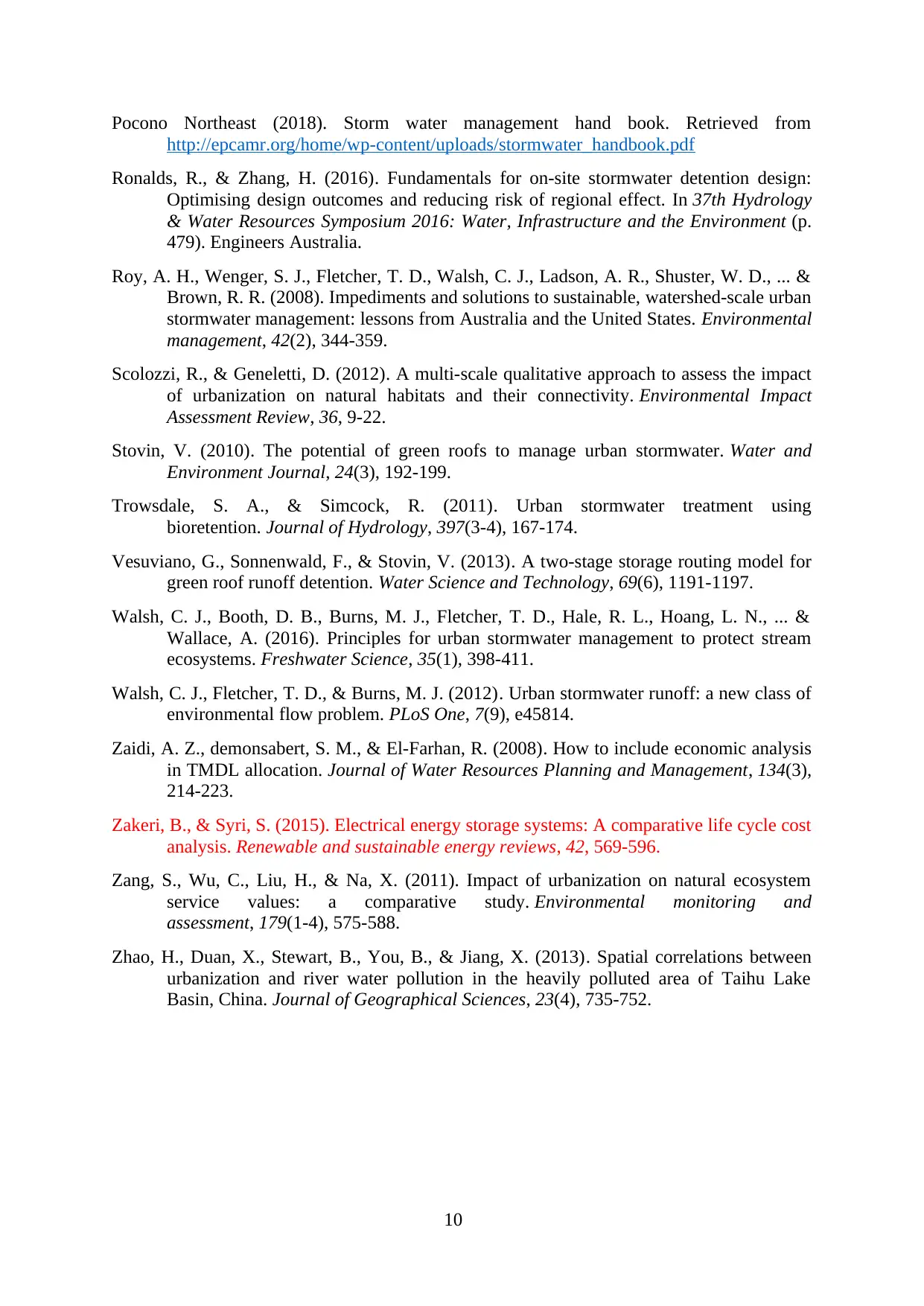
Pocono Northeast (2018). Storm water management hand book. Retrieved from
http://epcamr.org/home/wp-content/uploads/stormwater_handbook.pdf
Ronalds, R., & Zhang, H. (2016). Fundamentals for on-site stormwater detention design:
Optimising design outcomes and reducing risk of regional effect. In 37th Hydrology
& Water Resources Symposium 2016: Water, Infrastructure and the Environment (p.
479). Engineers Australia.
Roy, A. H., Wenger, S. J., Fletcher, T. D., Walsh, C. J., Ladson, A. R., Shuster, W. D., ... &
Brown, R. R. (2008). Impediments and solutions to sustainable, watershed-scale urban
stormwater management: lessons from Australia and the United States. Environmental
management, 42(2), 344-359.
Scolozzi, R., & Geneletti, D. (2012). A multi-scale qualitative approach to assess the impact
of urbanization on natural habitats and their connectivity. Environmental Impact
Assessment Review, 36, 9-22.
Stovin, V. (2010). The potential of green roofs to manage urban stormwater. Water and
Environment Journal, 24(3), 192-199.
Trowsdale, S. A., & Simcock, R. (2011). Urban stormwater treatment using
bioretention. Journal of Hydrology, 397(3-4), 167-174.
Vesuviano, G., Sonnenwald, F., & Stovin, V. (2013). A two-stage storage routing model for
green roof runoff detention. Water Science and Technology, 69(6), 1191-1197.
Walsh, C. J., Booth, D. B., Burns, M. J., Fletcher, T. D., Hale, R. L., Hoang, L. N., ... &
Wallace, A. (2016). Principles for urban stormwater management to protect stream
ecosystems. Freshwater Science, 35(1), 398-411.
Walsh, C. J., Fletcher, T. D., & Burns, M. J. (2012). Urban stormwater runoff: a new class of
environmental flow problem. PLoS One, 7(9), e45814.
Zaidi, A. Z., demonsabert, S. M., & El-Farhan, R. (2008). How to include economic analysis
in TMDL allocation. Journal of Water Resources Planning and Management, 134(3),
214-223.
Zakeri, B., & Syri, S. (2015). Electrical energy storage systems: A comparative life cycle cost
analysis. Renewable and sustainable energy reviews, 42, 569-596.
Zang, S., Wu, C., Liu, H., & Na, X. (2011). Impact of urbanization on natural ecosystem
service values: a comparative study. Environmental monitoring and
assessment, 179(1-4), 575-588.
Zhao, H., Duan, X., Stewart, B., You, B., & Jiang, X. (2013). Spatial correlations between
urbanization and river water pollution in the heavily polluted area of Taihu Lake
Basin, China. Journal of Geographical Sciences, 23(4), 735-752.
10
http://epcamr.org/home/wp-content/uploads/stormwater_handbook.pdf
Ronalds, R., & Zhang, H. (2016). Fundamentals for on-site stormwater detention design:
Optimising design outcomes and reducing risk of regional effect. In 37th Hydrology
& Water Resources Symposium 2016: Water, Infrastructure and the Environment (p.
479). Engineers Australia.
Roy, A. H., Wenger, S. J., Fletcher, T. D., Walsh, C. J., Ladson, A. R., Shuster, W. D., ... &
Brown, R. R. (2008). Impediments and solutions to sustainable, watershed-scale urban
stormwater management: lessons from Australia and the United States. Environmental
management, 42(2), 344-359.
Scolozzi, R., & Geneletti, D. (2012). A multi-scale qualitative approach to assess the impact
of urbanization on natural habitats and their connectivity. Environmental Impact
Assessment Review, 36, 9-22.
Stovin, V. (2010). The potential of green roofs to manage urban stormwater. Water and
Environment Journal, 24(3), 192-199.
Trowsdale, S. A., & Simcock, R. (2011). Urban stormwater treatment using
bioretention. Journal of Hydrology, 397(3-4), 167-174.
Vesuviano, G., Sonnenwald, F., & Stovin, V. (2013). A two-stage storage routing model for
green roof runoff detention. Water Science and Technology, 69(6), 1191-1197.
Walsh, C. J., Booth, D. B., Burns, M. J., Fletcher, T. D., Hale, R. L., Hoang, L. N., ... &
Wallace, A. (2016). Principles for urban stormwater management to protect stream
ecosystems. Freshwater Science, 35(1), 398-411.
Walsh, C. J., Fletcher, T. D., & Burns, M. J. (2012). Urban stormwater runoff: a new class of
environmental flow problem. PLoS One, 7(9), e45814.
Zaidi, A. Z., demonsabert, S. M., & El-Farhan, R. (2008). How to include economic analysis
in TMDL allocation. Journal of Water Resources Planning and Management, 134(3),
214-223.
Zakeri, B., & Syri, S. (2015). Electrical energy storage systems: A comparative life cycle cost
analysis. Renewable and sustainable energy reviews, 42, 569-596.
Zang, S., Wu, C., Liu, H., & Na, X. (2011). Impact of urbanization on natural ecosystem
service values: a comparative study. Environmental monitoring and
assessment, 179(1-4), 575-588.
Zhao, H., Duan, X., Stewart, B., You, B., & Jiang, X. (2013). Spatial correlations between
urbanization and river water pollution in the heavily polluted area of Taihu Lake
Basin, China. Journal of Geographical Sciences, 23(4), 735-752.
10
⊘ This is a preview!⊘
Do you want full access?
Subscribe today to unlock all pages.

Trusted by 1+ million students worldwide
1 out of 12
Related Documents
Your All-in-One AI-Powered Toolkit for Academic Success.
+13062052269
info@desklib.com
Available 24*7 on WhatsApp / Email
![[object Object]](/_next/static/media/star-bottom.7253800d.svg)
Unlock your academic potential
Copyright © 2020–2025 A2Z Services. All Rights Reserved. Developed and managed by ZUCOL.




